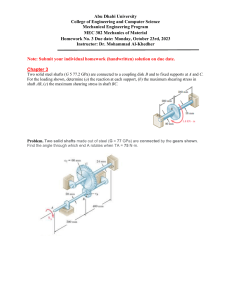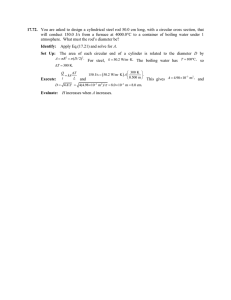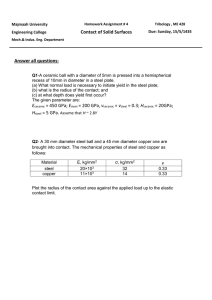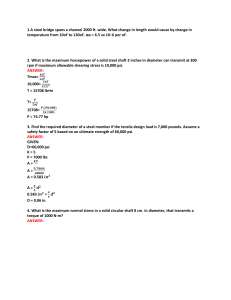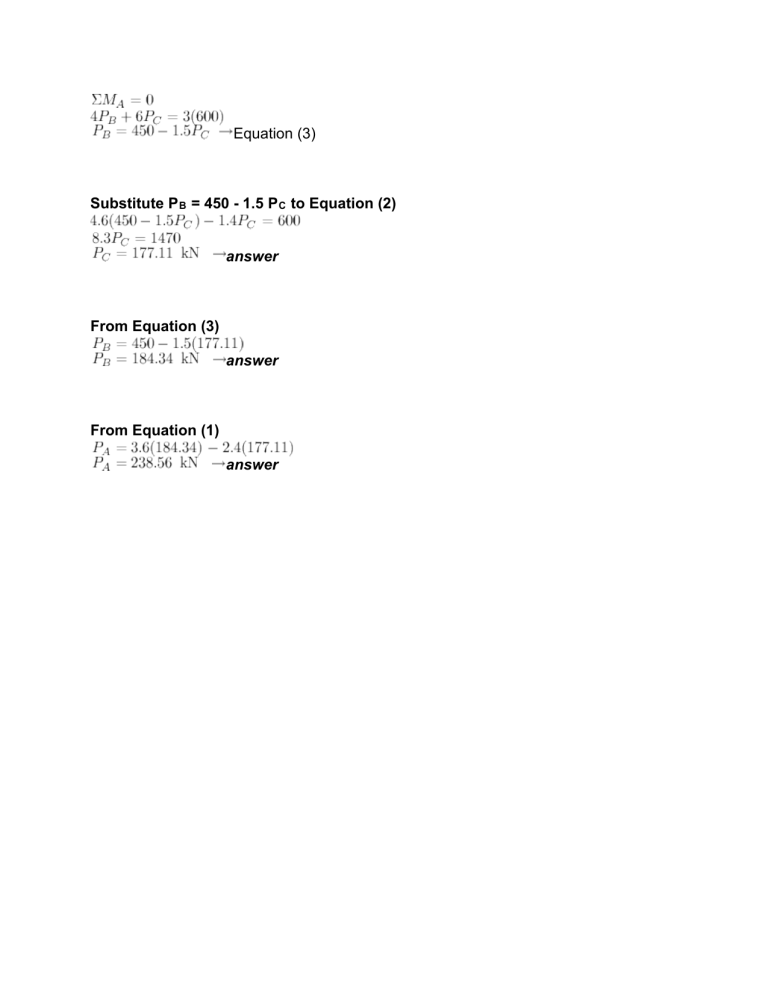
Equation (3) Substitute P B = 450 - 1.5 P C to Equation (2) answer From Equation (3) answer From Equation (1) answer Problem 256 Three rods, each of area 250 mm2, jointly support a 7.5 kN load, as shown in Fig. P256. Assuming that there was no slack or stress in the rods before the load was applied, find the stress in each rod. Use E st = 200 GPa and E br = 83 GPa. Solution 256 Equation (1) Equation (2) From Equation (1) answer From Equation (2) answer Problem 262 A steel rod is stretched between two rigid walls and carries a tensile load of 5000 N at 20°C. If the allowable stress is not to exceed 130 MPa at -20°C, what is the minimum diameter of the rod? Assume α = 11.7 µm/(m·°C) and E = 200 GPa. Solution 262 d Problem 263 answer Steel railroad reels 10 m long are laid with a clearance of 3 mm at a temperature of 15°C. At what temperature will the rails just touch? What stress would be induced in the rails at that temperature if there were no initial clearance? Assume α = 11.7 µm/(m·°C) and E = 200 GPa. Solution 263 Temperature at which answer Required stress: answer : Problem 265 A bronze bar 3 m long with a cross sectional area of 320 mm2 is placed between two rigid walls as shown in Fig. P-265. At a temperature of -20°C, the gap Δ = 2.5 mm. Find the temperature at which the compressive stress in the bar will be 35 MPa. Use α = 18.0 × 10-6 m/(m·°C) and E = 80 GPa. Problem 265 answer Problem 267 At a temperature of 80°C, a steel tire 12 mm thick and 90 mm wide that is to be shrunk onto a locomotive driving wheel 2 m in diameter just fits over the wheel, which is at a temperature of 25°C. Determine the contact pressure between the tire and wheel after the assembly cools to 25°C. Neglect the deformation of the wheel caused by the pressure of the tire. Assume α = 11.7 μm/(m·°C) and E = 200 GPa. Solution 267 answer Problem 268 The rigid bar ABC in Fig. P-268 is pinned at B and attached to the two vertical rods. Initially, the bar is horizontal and the vertical rods are stress-free. Determine the stress in the aluminum rod if the temperature of the steel rod is decreased by 40°C. Neglect the weight of bar ABC. Solution 268 Contraction of steel rod, assuming complete freedom: The steel rod cannot freely contract because of the resistance of aluminum rod. The movement of A (referred to as δ A ), therefore, is less than 0.4212 mm. In terms of aluminum, this movement is (by ratio and proportion): Equation (1) Equation (2) Equations (1) and (2) answer Problem 269 As shown in Fig. P-269, there is a gap between the aluminum bar and the rigid slab that is supported by two copper bars. At 10°C, Δ = 0.18 mm. Neglecting the mass of the slab, calculate the stress in each rod when the temperature in the assembly is increased to 95°C. For each copper bar, A = 500 mm2, E = 120 GPa, and α = 16.8 µm/(m·°C). For the aluminum bar, A = 400 mm2, E = 70 GPa, and α = 23.1 µm/(m·°C). Solution 269 Assuming complete freedom: From the figure: answer answer Problem 272 For the assembly in Fig. 271, find the stress in each rod if the temperature rises 30°C after a load W = 120 kN is applied. Solution 272 Equation (1) answer answer Problem 275 A rigid horizontal bar of negligible mass is connected to two rods as shown in Fig. P275. If the system is initially stress-free. Calculate the temperature change that will cause a tensile stress of 90 MPa in the brass rod. Assume that both rods are subjected to the change in temperature. Solution 275 drop in temperature answer Problem 276 Four steel bars jointly support a mass of 15 Mg as shown in Fig. P-276. Each bar has a cross-sectional area of 600 mm2. Find the load carried by each bar after a temperature rise of 50°C. Assume α = 11.7 µm/(m·°C) and E = 200 GPa. Solution 276 Equation (1) answer answer 1 Problem 304 A steel shaft 3 ft long that has a diameter of 4 in is subjected to a torque of 15 kip·ft. Determine the maximum shearing stress and the angle of twist. Use G = 12 × 106 psi. Solution 304 answer answer Problem 305 What is the minimum diameter of a solid steel shaft that will not twist through more than 3° in a 6-m length when subjected to a torque of 12 kN·m? What maximum shearing stress is developed? Use G = 83 GPa. Solution 305 answer 2 answer Problem 306 A steel marine propeller shaft 14 in. in diameter and 18 ft long is used to transmit 5000 hp at 189 rpm. If G = 12 × 106 psi, determine the maximum shearing stress. Solution 306 answer Problem 307 A solid steel shaft 5 m long is stressed at 80 MPa when twisted through 4°. Using G = 83 GPa, compute the shaft diameter. What power can be transmitted by the shaft at 20 Hz? 3 Solution 307 answer answer Problem 308 A 2-in-diameter steel shaft rotates at 240 rpm. If the shearing stress is limited to 12 ksi, determine the maximum horsepower that can be transmitted. Solution 308 4 answer Problem 309 A steel propeller shaft is to transmit 4.5 MW at 3 Hz without exceeding a shearing stress of 50 MPa or twisting through more than 1° in a length of 26 diameters. Compute the proper diameter if G = 83 GPa. Solution 309 Based on maximum allowable shearing stress: Based on maximum allowable angle of twist: Use the bigger diameter, d = 352 mm answer
